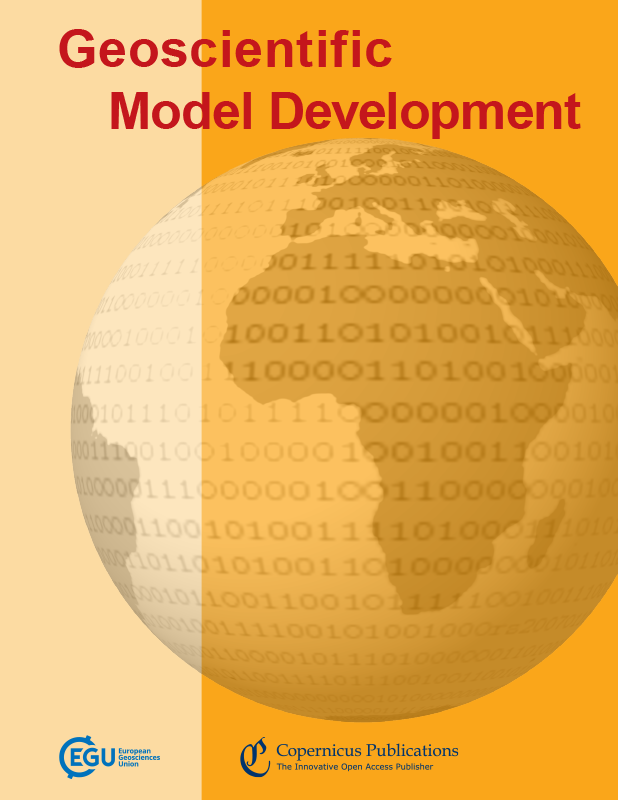通过水平通量重新分布模拟全球化学-气候模式(EMAC v2.55.2)中的横向重力波传播
IF 4
3区 地球科学
Q1 GEOSCIENCES, MULTIDISCIPLINARY
引用次数: 1
摘要
摘要天气和气候模式中重力波(GW)参数化的柱状方法已被确定为中大气动力学中动力偏差的潜在原因。例如,由于缺乏水平地形的GW动量传播,模式和观测值在60°S下的GW动量通量(GWMF)存在差异,这被怀疑是导致南极极地涡旋表现不足的原因。然而,由于将模型域分解为不同的计算任务来并行化,水平网格盒之间的通信在计算上非常昂贵,使得GWs的水平传播对于全球化学-气候模拟不可行。为了克服这个问题,我们提出了一种简化的解决方案,通过定制的重分布图在单一高度重新分布GWMF来近似水平GW传播。为了生成每个网格框平均的全球再分布地图,我们使用参数化方法将地形描述为一组具有指定位置、方向和高度的山脊,并结合射线追踪模型描述由此产生的山波的横向传播。在全球化学-气候模式(CCM) EMAC (ECHAM凌乱大气化学)中,这些地图允许我们在一个水平上重新分配GW动量通量,从而获得负担得起的计算资源开销。我们的模拟结果显示,与纯柱状方法相比,GWMF和阻力模式在水平方向上更加分散;GWs现在也出现在海洋和没有山脉的地区。在本文中,我们详细描述了如何计算再分布映射以及如何在CCM中实现GWMF再分布。此外,分析表明为什么15公里是重新分配的理想高度。重新分布的地形GWMF的第一个结果提供了明确的证据,表明南半球重新分布的GW阻力有可能改变和改善南极极地涡旋动力学,从而为提高CCM模拟和极地平流层臭氧预估的可信度铺平了道路。本文章由计算机程序翻译,如有差异,请以英文原文为准。
Emulating lateral gravity wave propagation in a global chemistry–climate model (EMAC v2.55.2) through horizontal flux redistribution
Abstract. The columnar approach of gravity wave (GW) parameterisations in weather and climate models has been identified as a potential reason for dynamical biases in middle-atmospheric dynamics. For example, GW momentum flux (GWMF) discrepancies between models and observations at 60∘ S arising through the lack of horizontal orographic GW propagation are suspected to cause deficiencies in representing the Antarctic polar vortex. However, due to the decomposition of the model domains onto different computing tasks for parallelisation, communication between horizontal grid boxes is computationally extremely expensive, making horizontal propagation of GWs unfeasible for global chemistry–climate simulations. To overcome this issue, we present a simplified solution to approximate horizontal GW propagation through redistribution of the GWMF at one single altitude by means of tailor-made redistribution maps. To generate the global redistribution maps averaged for each grid box, we use a parameterisation describing orography as a set of mountain ridges with specified location, orientation and height combined with a ray-tracing model describing lateral propagation of so-generated mountain waves. In the global chemistry–climate model (CCM) EMAC (ECHAM MESSy Atmospheric Chemistry), these maps then allow us to redistribute the GW momentum flux horizontally at one level, obtaining an affordable overhead of computing resources. The results of our simulations show GWMF and drag patterns that are horizontally more spread out than with the purely columnar approach; GWs are now also present above the ocean and regions without mountains. In this paper, we provide a detailed description of how the redistribution maps are computed and how the GWMF redistribution is implemented in the CCM. Moreover, an analysis shows why 15 km is the ideal altitude for the redistribution. First results with the redistributed orographic GWMF provide clear evidence that the redistributed GW drag in the Southern Hemisphere has the potential to modify and improve Antarctic polar vortex dynamics, thereby paving the way for enhanced credibility of CCM simulations and projections of polar stratospheric ozone.
求助全文
通过发布文献求助,成功后即可免费获取论文全文。
去求助
来源期刊

Geoscientific Model Development
GEOSCIENCES, MULTIDISCIPLINARY-
CiteScore
8.60
自引率
9.80%
发文量
352
审稿时长
6-12 weeks
期刊介绍:
Geoscientific Model Development (GMD) is an international scientific journal dedicated to the publication and public discussion of the description, development, and evaluation of numerical models of the Earth system and its components. The following manuscript types can be considered for peer-reviewed publication:
* geoscientific model descriptions, from statistical models to box models to GCMs;
* development and technical papers, describing developments such as new parameterizations or technical aspects of running models such as the reproducibility of results;
* new methods for assessment of models, including work on developing new metrics for assessing model performance and novel ways of comparing model results with observational data;
* papers describing new standard experiments for assessing model performance or novel ways of comparing model results with observational data;
* model experiment descriptions, including experimental details and project protocols;
* full evaluations of previously published models.
 求助内容:
求助内容: 应助结果提醒方式:
应助结果提醒方式:


